Visit Satya Dharma Temple To Uncover The Spiritual Legacy Of Bali
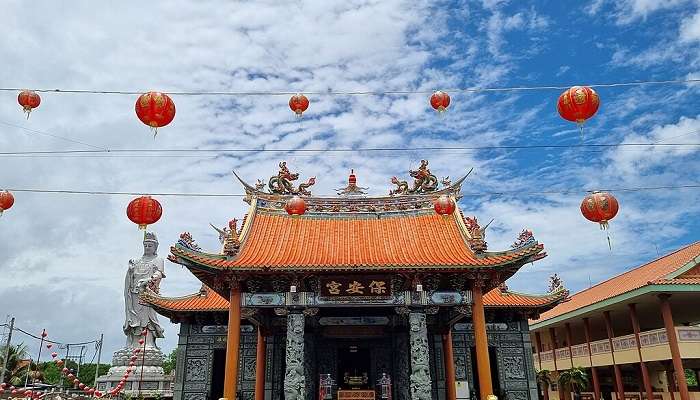
In the green surroundings of Bali, the Satya Dharma Temple is a respected holy haven. It welcomes people to explore Bali’s deep Hindu roots. The temple’s impressive detailed carvings and calm gardens provide a moving experience. Paying homage to the sacred Sang Hyang Widhi Wasa, the Satya Dharma Temple is known for its mix of designs. It combines Balinese, Buddhist, and Hindu styles flawlessly. As a centre for spiritual practice and culture, the temple is a passage to understanding Bali’s multifaceted religious customs. It highlights their lasting place in the devotion of the island’s followers.
Places To Visit Near Satya Dharma Temple
While visiting the Satya Dharma Temple, you can also explore other tourist attractions. Some of them are listed below.
1. Pura Tirta Empul
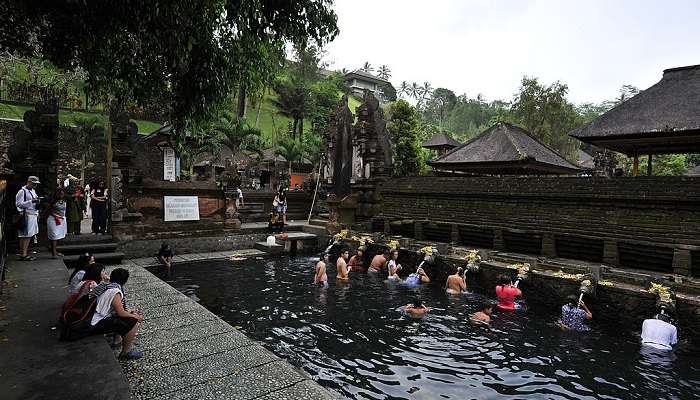
Situated in Bali’s heartland, Pura Tirta Empul is a respected Hindu water temple, deeply rooted in the island’s traditions. This enchanting place is famous for its age-old purification springs. Locals and tourists participate in the time-honoured cleansing practices that have been carried out here over the ages. Stepping into the temple, your eyes meet the main bathing areas, replenished by the clean waters springing up from natural sources. Unique stone fountains ornate the pool edges, each one signifying a Hindu god.
Believers can be spotted plunging into the holy waters, carrying out rituals, and purifying themselves. They believe this water has a mighty healing and purifying effect. Points of interest beyond the primary bathing spots include extra shrines, pavilions, and sacred corners adding to the total site’s tranquil and spiritual vibe. Visitors are welcome to examine the detailed stone crafts, appreciate the colourful flower tributes, and witness the array of ceremonies happening in the course of the day.
Entry Fees: IDR 50,000 for adults and IDR 30,000 for children
Timings: 8:00 AM to 5:00 PM
Must Read: Things To Do In Bali
2. Campuhan Ridge Walk
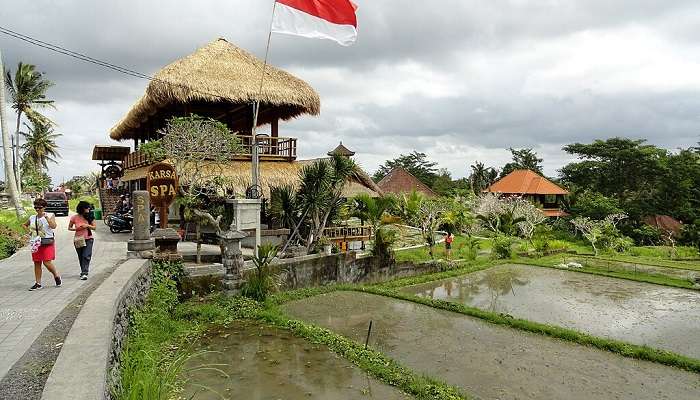
In the centre of Ubud, Bali, you’ll find the inviting Campuhan Ridge Walk. It’s a tranquil hiking trail that pulls you away from the city’s noise. This 9-kilometre (5.6-mile) path takes you through beautiful, green landscapes. You can see the hills and valleys all around while you’re walking. Once you start on the Campuhan Ridge Walk, you dive right into the calm nature of Ubud. The path takes you through a forest that’s bursting with life.
You might spot monkeys, birds, and butterflies as you make your way along the trail. As you walk further, you start climbing, offering amazing views of the Campuhan River Valley and Ubud’s rolling hills. A unique part of the Campuhan Ridge Walk is watching as the light and weather shift during the day. Mist often lies on the trail in the early morning, giving it an almost magical feel. In the afternoon, you can see the greenery all around. But sunset is something special. The path is covered in soft, golden light, making the experience unforgettable.
Entry Fees: No Entry Fee
Timings: 6:00 AM to 6:00 PM
3. Tegalalang Rice Terraces
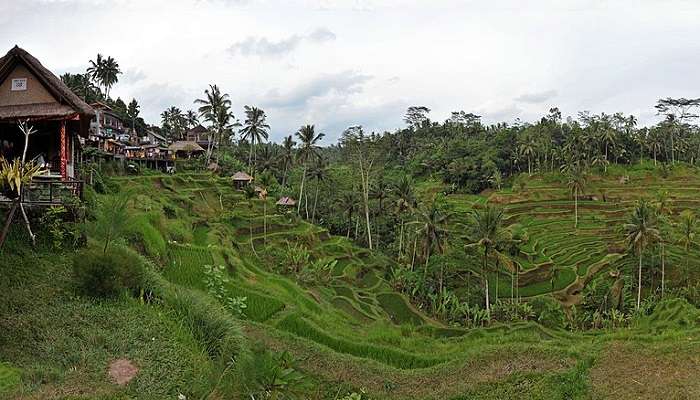
Right in the heart of vibrant Bali, you’ll find the amazing spectacle that is the Tegalalang Rice Terraces. Bounding over hills and valleys, these famous fields of rice draw in sightseers from around the world. The terraces, like giant steps etched into the rich, green countryside, form an eye-catching pattern. It’s impossible not to be amazed at the widespread beauty of these terraces as you draw near.
The design of the fields cloaked in lush green, seems to go on forever and blend effortlessly with the surrounding hills and valleys. If you stroll around the Tegalalang Rice Terraces, you’ll get a real feel for the calmness of the place. This UNESCO World Heritage site is complete with the melodic sound of water flowing from the local Balinese irrigation method called Subak. Plus, the hushed whispers of the rice plants waving in the breeze just add to the serene environment.
Entry Fees: IDR 15,000 per person
Timings: 6:00 AM to 6:00 PM
Suggested Read: Denpasar Temples
4. Goa Gajah
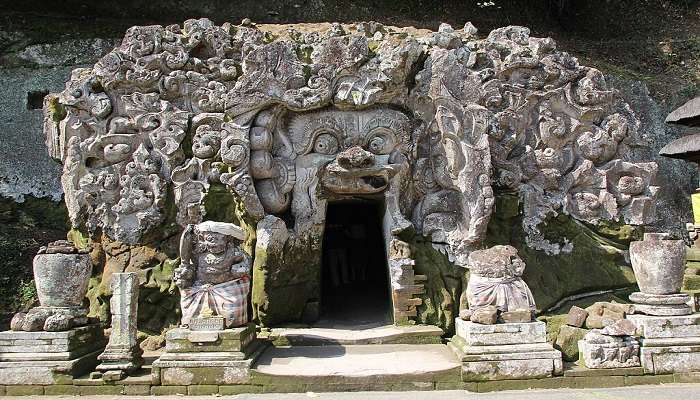
Central Bali is home to the amazing Goa Gajah, also known as the Elephant Cave. This old cave temple is surrounded by lush green nature. It’s been stunning people for hundreds of years. Hailing from the 9th century, it provides a peek into Bali’s strong cultural and spiritual past. First off, the Goa Gajah displays a large rock entrance. Carved into the shape of a mythical creature’s mouth, it’s hard to miss!
This fancy entrance is the door to the temple, featuring deep carvings, quiet caves for introspection, and dip pools. Once inside, folks can check out the main peace-seeking cave. Here, they will spot a variety of age-old stone sculptures and detailed reliefs. These complex designs show different Hindu gods, like Ganesha, the elephant-headed deity, and episodes from the Ramayana and Mahabharata tales. The cave’s soft, moody light enhances the mystical and solemn mood filling the area.
Entry Fees: IDR 50,000 for adults and IDR 30,000 for children
Timings: 7:00 AM to 5:00 PM
5. Ubud Monkey Forest
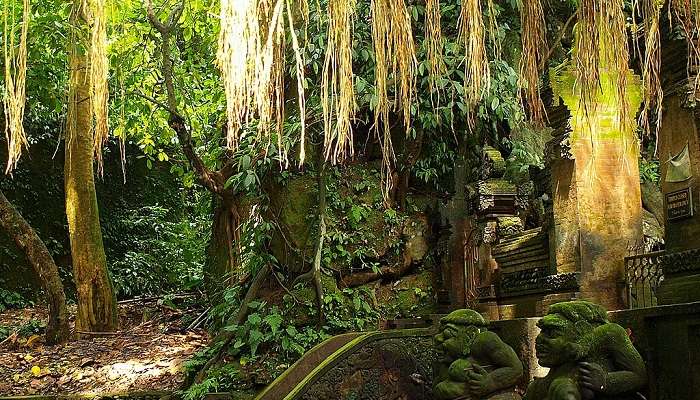
Not far from the Satya Dharma Temple is the Ubud Monkey Forest, a captivating greenspace. Here you’ll find over 700 grey long-tailed macaques. People come from far and wide to see these monkeys play in their natural home. This Forest is special. It’s more than a safe space for Bali’s monkeys. It’s a sacred place in Hindu belief too. Step into the Forest, and you’re in an instant jungle. Big trees and winding trails all around.
Do you see the monkeys? They’re the star here! Some dash across the ground, some swing from branch to branch, and some even interact with the visitors. But remember, don’t feed them. These monkeys can get quite cheeky. But the Forest is not just a playfield for the monkeys. There are old Hindu temples and shrines too. These are holy places for the locals. Take your time, explore. You’ll learn a lot about the Forest’s cultural meaning and how it fits into Bali’s Hindu customs.
Entry Fees: IDR 80,000 for adults and IDR 60,000 for children
Timings: 8:30 AM to 6:00 PM
Suggested Read: Temples In Sanur Bali
6. Pura Taman Saraswati
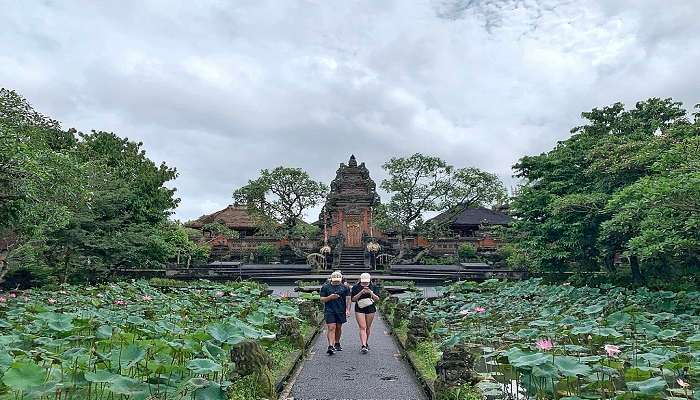
Ubud’s Pura Taman Saraswati, a mesmerising water palace, is a local treasure. It’s located not far from the Satya Dharma Temple. This palace is devoted to Saraswati – the deity who Hindus identify as the goddess of knowledge, arts, and music. The palace is well-known for its intricate lotus ponds and mesmerising Balinese and Javanese-style architecture. Its peaceful gardens captivate visitors. When you get to Pura Taman Saraswati, the main entrance’s ornate stone gates will astound you.
Crossing the expertly crafted stone bridges, you’ll meet the sight of serene lotus ponds. The vibrant flowers adrift upon peaceful waters, echoed by lush greenery and the temple’s unique architecture, form an unforgettable view. The architectural focus is the primary shrines, boasting multi-tiered roofs, along with the ornate stone pavilions scattered across the site. They meld Javanese and Balinese designs, acknowledging the rich cultural past that has shaped the development of this temple over many decades.
Entry Fees: IDR 40,000 per person
Timings: 8:00 AM to 6:00 PM
Further Read: Bali Temples
Take a trip to the Satya Dharma Temple. Here, old customs have lasted for years. You can see special rituals, visit holy places, and feel the deep spirit that fills this sacred site. Learn more about Bali’s full culture and religious history. Be a part of the calm and changing mood of this special temple. Get set for an exciting visit to the Satya Dharma Temple and unveil the spiritual marvels of this sacred Balinese retreat at. Organise your stay, book your trip to Bali, and gear up for a transformative journey that’ll enhance your understanding of Bali’s vibrant cultural and religious customs.
For our editorial codes of conduct and copyright disclaimer, please click here.
Cover Image Credit: Softwarestatistik for wikimedia commons
Frequently Asked Questions About Satya Dharma Temple
What is the Satya Dharma Temple?
You might also know it as Sri Satya Dharma Mandir! This remarkable Hindu place of worship sits in Ubud, Bali, Indonesia. It's a special site, focusing on truth and righteousness. Interested, right? Traditional Balinese and Indian architecture combine here. Plus, it's a hub for local religious and cultural activities.
What is the history of Satya Dharma Temple history?
We ll, the Satya Dharma Temple history begins back in the 14th century, under the rule of the Majapahit Empire. This powerful Hindu-Buddhist kingdom pretty much controlled Indonesia. The temple stands as a testament to its time, witnessing various extensions and upgrades. That tells us about its significant role in Balinese Hindu traditions.
What is the Sri Satya Dharma Mandir?
You might know it as Satya Dharma Temple. Sri Satya Dharma Mandir is a famous Hindu temple in Ubud, Bali, Indonesia. The temple, a key spiritual place, is deeply rooted in Hindu truth and righteousness, known as Satya Dharma. Its complex design is a blend of traditional Balinese and Indian architectural styles. Plus, it plays a crucial part in the religion and culture of the locals.
What are the Satya Dharma Temple timings?
The Satya Dharma Temple is open every day, from 8:00 AM to 6:00 PM. Changes might occur on special days or during ceremonies, so check out the website or ask locally to be sure about Satya Dharma Temple timings.
What is the entry fee to enter the Satya Dharma Temple?
No, the Satya Dharma Temple welcomes all for free! But, remember, it's a place of worship. So, wear modest and respectful clothing. Long trousers or skirts are ideal, and shirts should cover shoulders.
People Also Read:
Chaturbhuj Temple Kalyani Devi Temple Shree Dwarkadhish Temple

Unveil the hidden treasures of the globe and turn every travel dream into reality. As a Content Writer, I am passionate enough to craft stories from ancient wonders to modern marvels. My words paint the picture-perfect itinerary for unforgettable experiences. Let my words be your trusted guide to immerse in the diverse culture and discover the beauty of the unknown.











